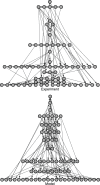Hierarchical self-organization of non-cooperating individuals
- PMID: 24349070
- PMCID: PMC3859486
- DOI: 10.1371/journal.pone.0081449
Hierarchical self-organization of non-cooperating individuals
Abstract
Hierarchy is one of the most conspicuous features of numerous natural, technological and social systems. The underlying structures are typically complex and their most relevant organizational principle is the ordering of the ties among the units they are made of according to a network displaying hierarchical features. In spite of the abundant presence of hierarchy no quantitative theoretical interpretation of the origins of a multi-level, knowledge-based social network exists. Here we introduce an approach which is capable of reproducing the emergence of a multi-levelled network structure based on the plausible assumption that the individuals (representing the nodes of the network) can make the right estimate about the state of their changing environment to a varying degree. Our model accounts for a fundamental feature of knowledge-based organizations: the less capable individuals tend to follow those who are better at solving the problems they all face. We find that relatively simple rules lead to hierarchical self-organization and the specific structures we obtain possess the two, perhaps most important features of complex systems: a simultaneous presence of adaptability and stability. In addition, the performance (success score) of the emerging networks is significantly higher than the average expected score of the individuals without letting them copy the decisions of the others. The results of our calculations are in agreement with a related experiment and can be useful from the point of designing the optimal conditions for constructing a given complex social structure as well as understanding the hierarchical organization of such biological structures of major importance as the regulatory pathways or the dynamics of neural networks.
Conflict of interest statement
Figures




References
-
- Salthe SN (1985) Evolving Hierarchical Structures. New York: Columbia University Press. 343 p.
-
- Sethi SP, Zhang Q (1994) Hierarchical Decision Making in StochasticManufacturing Systems. Boston: Birkhäuser. 422 p.
-
- Pumain D, editor (2006) Hierarchy in Natural and Social Sciences. Dodrecht: Springer. 244 p.
-
- Lane D (2006) Hierarchy, Complexity, Society. In: Pumain D, editor. Hierarchy in Natural and Social Sciences, Methodos Series Volume 3. Dodrecht: Springer. 81–119.
-
- Dubreuil B (2010) Human Evolution and the Origins of Hierarchies: The State of Nature. Cambridge: Cambridge University Press. 288 p.
Publication types
MeSH terms
LinkOut - more resources
Full Text Sources
Other Literature Sources

